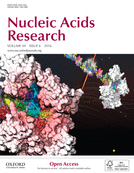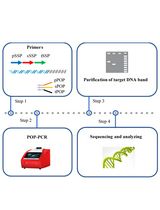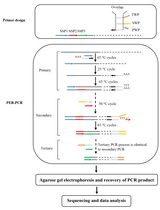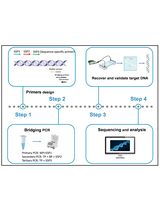- EN - English
- CN - 中文
Measurement of the Length of the Integrated Donor DNA during Bacillus subtilis Natural Chromosomal Transformation
枯草芽孢杆菌自然遗传转化过程中完整供体DNA长度的测定
发布: 2019年08月20日第9卷第16期 DOI: 10.21769/BioProtoc.3338 浏览次数: 4080
评审: Alba BlesaChangyi ZhangJing Li
Abstract
For natural transformation to occur, bacterial cells must first develop a programmed physiological state called competence. Competence in Bacillus subtilis, which occurs only in a fraction of cells, is a transient stress response that allows cells to take up DNA from the environment. During natural chromosomal transformation, the internalized linear single-stranded (ss) DNA recombines with the identical (homologous) or partially identical (homeologous) sequence of the resident duplex. The length of the integrated DNA, which can be measured, depends on the percentage of sequence divergence between the donor (internalized) and the recipient (chromosomal) DNAs.
The following protocol describes how to induce the development of competence in B. subtilis cells, how to transform them with donor DNAs representing different percentages of sequence divergence compared with the recipient chromosomal DNA, how to calculate the chromosomal transformation efficiency for each of them, and how to amplify the chromosomal DNA from the transformants in order to measure the length in base pairs (bp) of the integrated donor DNA.
Background
Natural transformation is a bacterial programmed mechanism mediated by natural competence systems encoded in the genomes of many bacteria (Chen and Dubnau, 2004; Chen et al., 2005; Takeuchi et al., 2014; Johnston et al., 2014). Competence development allows cells to take up DNA from the environment (Chen and Dubnau, 2004; Chen et al., 2005; Thomas and Nielsen, 2005; Kidane et al., 2012; Yadav et al., 2012; Yadav et al., 2013; Takeuchi et al., 2014; Johnston et al., 2014).
In Bacillus subtilis transient natural competence is induced in a subset of cells by starving them of critical nutrients (Kidane et al., 2012; Chen and Dubnau, 2004). In the competent subpopulation, DNA replication is halted, expression of a set of genes is induced, and the DNA uptake apparatus is built at one cell pole (Chen and Dubnau, 2004; Kidane et al., 2012). The DNA uptake apparatus binds environmental double-stranded (ds) DNA, degrades one of the strands, transports the other strand (independently of its nucleotide sequence and polarity) through the cell wall and the membrane into the cytosol. During chromosomal transformation, the incoming single-stranded (ss) DNA is integrated into the recipient dsDNA replacing homologous (or partially homologous) chromosomal sequences (Kidane et al., 2012).
It has been already shown that the divergence between the sequences of the internalized and the recipient DNAs, provides a barrier to chromosomal transformation and decreases the length of integration of donor DNA (Carrasco et al., 2016; Carrasco et al., 2019).
In this protocol, we describe how to transform B. subtilis competent cells to finally measure the length of the integrated DNA. The experimental procedure described here to prepare B. subtilis competent cells is an adaptation of the previous described by Dubnau et al., 1973 and Alonso et al., 1988.
Materials and Reagents
- Petri dishes 90 mm (VWR, catalog number: 391-0440)
- Sterile wood toothpicks
- Sterile pipette tips
- 50- and 100-ml Flasks (Duran, catalog numbers: 21-216-17 and 21-216-24, respectively)
- 1.5- and 2-ml tubes (Sarstedt, catalog number: 72.690.001; Fisherbrand, catalog number: 11393613)
- Polystyrol/Polystyrene cuvettes 10 x 4 x 45 mm (SARSTEDT, catalog number: 67742)
- Semi-log paper
- Glass beads 3 mm (Sigma-Aldrich, catalog number: Z143928-1EA)
- Bacillus subtilis cells (wild-type strain [B. subtilis 168] or derivative deletion mutants)
- Primers (Sigma-Aldrich)
Forward primer: 5′-CATATAATACGCATGATTTGAGGGG
Reverse primer: 5′-GTCCGTCGTAAAGCACTGTTTTG - Plasmids: pCB980; pCB981; pCB982; pCB983; pCB984; pCB1054; pCB985; pCB1056
Note: These plasmids have been previously reported in Carrasco et al., 2016 and Carrasco et al., 2019. - Escherichia coli 2,710-bp pUC57 vector
- Bi-distilled H2O (ddH2O)
- Glycerol (Sigma-Aldrich, catalog number: G6279-4L)
- Rifampicin (Sigma-Aldrich, catalog number: 13292-46-1)
- Ampicillin sodium salt (Sigma-Aldrich, catalog number: 69-52-3)
- Plasmid purification kit (Qiagen plasmid mini kit, catalog number: 27106)
- Bacto tryptone pancreatic digest of casein (BD Biosciences, catalog number: 211705)
- Bacto yeast extract (Extract of autolyzed yeast cells) (BD Biosciences, catalog number: 211750)
- European bacteriological agar (Pronadisa, catalog number: 1800)
- NaCl (VWR, catalog number: 7647-14-5)
- Agarose D1 medium EEO (Pronadisa, catalog number: 8021)
- PCR purification kit (Speedtools PCR clean up kit, Biotools, catalog number: 740609.50.205571)
- Na2HPO4 (Calbiochem, Merck, catalog number: 7558-79-4)
- KH2PO4 (Calbiochem, Merck, catalog number: 7778-77-0)
- K2HPO4 (Calbiochem, Merck, catalog number: 16788-57-1)
- D-(+)-Glucose (Sigma-Aldrich, catalog number: 50-99-7)
- Tri-Sodium citrate dihydrate (Na3C6O7·2H2O) (Merck, catalog number: 6132-04-3)
- Ammonium sulfate (MP Biomedical, catalog number: 7783-20-2)
- Titriplex III (EDTA) (Merck, catalog number: 6381-92-6)
- Acetic acid glacial (AppliChem PanReac, catalog number: 141008.1214)
- Casein hydrolysate (EMD, catalog number: 65072-00-6)
- CaCl2·2H2O (Merck, catalog number: 10035-04-8)
- MgSO4·7H2O (Merck, catalog number: 10034-99-8)
- Tryptophan (Merck, catalog number: 54-12-6)
- Methionine (Merck, catalog number: 63-68-3)
- Tris-HCl (AppliChem PanReac, catalog number: A1086)
- 1 M Tris-HCl, pH 7.5 (see Recipes)
- Luria Bertani (LB) broth (see Recipes)
- LB-agar (see Recipes)
- GM1 (see Recipes)
- GM2 (see Recipes)
- SBase10x (see Recipes)
- TAE 50x (see Recipes)
Equipment
- Pipettes
- 30 and 37 °C incubators
- Amersham Biosciences Ultrospec 3100 Pro UV/Visible Spectrophotometer (GE Healthcare)
- Heating block
- Microcentrifuge
- Thermal cycler (VWR, Doppio, catalog number: 732-2551)
- NanoDropTM 1000 Spectrophotometer (Thermo Fisher Scientific)
- Autoclave
- -80 °C freezer
Software
- Sequence data compilation
Sequences of rpoB genes from different Bacillus species or subspecies need to be downloaded from relevant databases. A recommended database is NCBI. A single C to T transition mutation at codon 482 (position 1,446) in the house-keeping rpoB gene, confers resistance to rifampicin (RifR). To generate the rpoB482 sequence variants, a C to T change is required at the position 1,446 of each sequence (see Figure 1A, asterisk). - Online tool (BLAST) to perform the nucleotide alignment
Procedure
文章信息
版权信息
© 2019 The Authors; exclusive licensee Bio-protocol LLC.
如何引用
Serrano, E. and Carrasco, B. (2019). Measurement of the Length of the Integrated Donor DNA during Bacillus subtilis Natural Chromosomal Transformation. Bio-protocol 9(16): e3338. DOI: 10.21769/BioProtoc.3338.
分类
微生物学 > 微生物遗传学 > 转化
分子生物学 > DNA > PCR
分子生物学 > DNA > 转化
您对这篇实验方法有问题吗?
在此处发布您的问题,我们将邀请本文作者来回答。同时,我们会将您的问题发布到Bio-protocol Exchange,以便寻求社区成员的帮助。
Share
Bluesky
X
Copy link












